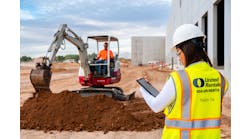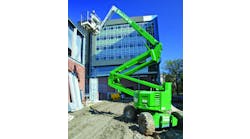Participants:
Participants:
John Vogel, vice president of sales – handheld tools, Chicago Pneumatic Construction Tools, Westfield, Mass.
Kathryn Reissig, marketing services manager, Stone Construction Equipment, Honeoye, N.Y.
Frank Multerer, president, MBW, Slinger, Wis.
Gayle Suiter, sales and marketing administrator, Arrow-Master Inc., East Moline, Ill.
Tom Carroll, president, CS Unitec, Norwalk, Conn.
Anthony Corwin, product manager, Commercial Products, Makita, La Mirada, Calif.
Ben Weise, product manager for trowels and screeds, Multiquip, Carson, Calif.
RER: What are some of the latest trends in concrete equipment in terms of technology, enhancements and features?
Vogel: More and more customers are using rivet busters in concrete applications in place of 60-pound breakers. Because operating a rivet buster is less fatiguing, it generally increases operator productivity in many applications.
Reissig: Equipment to work specialty concrete — colors, aerated, lightweight, etc. For example the Buddy by Stone mortar mixers are designed for optimum blending. The dynamic mixing feature, along with the drum configuration, delivers a more complete blend in a shorter period of time.
Multerer: MBW runs counter to trends as often as not. For example, while the industry has trended to larger, heavier, and evermore enhancement-laden riding trowels, MBW has held to a measured approach that emphasizes matching design, weight, horsepower and enhancements to application requirements. Our hydraulic steer, mechanical transmission 10-foot rider (BK12-160K) weighs approximately 1,500 pounds and produces more than enough torque to break pans loose with a 40-hp Kohler engine. This compares to competitive 10 footers weighing upwards of 2,500 pounds with 50-hp engines and hydraulic rotors. The lighter MBW rider gets on the concrete earlier and widens the floating/finishing window, consumes less fuel, and is generally free of transmission problems stemming from heavier, higher horsepower/torque designs.
Of course, there is risk in running counter to trends. The greatest risk is that users sometimes fail to appreciate such an approach. But users pay the piper in the form of higher acquisition, operating, and maintenance costs when they buy into commercial propaganda promoting heavier, higher horsepower/torque machinery. And speaking of trends, manufacturers get caught up in the oneupmanship of their own making. More horsepower is needed to power fully hydrostatic riding trowels. Heavier frames and transmissions are needed to deal with higher horsepower and torque. Suddenly, you have a 2,500-pound machine the weight of which has more to do with handling higher horsepower and torque and less to do with floating/finishing concrete. MBW has bucked the trend and kept its eye on the target.
Carroll: Things haven’t really changed from last year, people are always looking for lighter weight, faster-working and safer tools — those are the three general headings that are going to remain universal to power tools. You see tools evolve over time. The interesting thing about the business is the evolution of technology. In concrete-working power tools or equipment, drilling and sawing are the two biggest areas.
We have seen with our pneumatic walk-behind concrete saw and our pneumatic concrete hand-held saws an increase in business and part of that is due to the lightweight nature of our 20-inch walk-behind saw. It weighs 107 pounds versus 300-plus pounds for gasoline and diesel saws in that capacity. We’ve seen a lot of small municipalities and small contractors getting that product because one or two men can lift it into the back of a small truck as opposed to using a hoist or a ramp to drive one of these self-propelled models. That’s an area where we’ve seen an increase on the sawing end of it.
Technology has also evolved in diamond saw chains — we’ve had the pneumatic one on the market for about four years. The advantages are obvious — square corners and plunge cutting, a smaller package or system as opposed to a wall saw, which is many hundreds of pounds and then needs to be tracked up on the wall. The chain saw, and we have the pneumatic version, is good for making small openings, mechanical openings and making square cuts, and squaring off corners, which you can’t do with a circular blade.
Corwin: Makita sees a need for a broad range of rotary hammers equipped with more features. Power will remain important, but comfort, speed and efficiency features like vibration reduction will increasingly come into play. With more choices, pro end users will be able to match applications with concrete drilling products that deliver both more work and more comfort, all day long.
Makita does not see comfort and performance as mutually exclusive. On jobsites across America, more and more tradesmen are telling us that they want more drilling power and speed, but less vibration. Three years ago Makita introduced Anti-Vibration Technology (AVT) an exclusive counterbalance design that reduces vibration up to three times, with less noise and more efficient power. With less vibration, the end result is more energy directed to the bit and the work surface, and not to the end-user, and vibration reduction becomes a measure in both comfort and efficiency. Makita offers four rotary hammers equipped with AVT, and more models will be added to expand the product options for this important feature.
Another trend is a broader assortment of products that allow the end-user to better match the tool to the task. For example, Makita offers lighter-weight models for overhead drilling, and more compact L-handle models for working in compact spaces. Makita offers rotary hammers in SDS-Max, SDS-Plus, and Spline shanks in a range of sizes, equipped with a variety of comfort and efficiency features. This broad product line is a result of designing and building products based on the variety of applications that pro tradesmen face every day. With more options, it’s better for the end-user.
Weise: Serviceability and sustainability are key. Manufacturers are taking into account the green features of their equipment and making sure they are able to rebuild equipment.
How is the movement toward green building initiatives affecting how concrete equipment is designed, how it performs and what the customer expectations are for it?
Vogel: Chicago Pneumatic is encouraging all customers to use our biodegradable hammer oil in all operations. We hope that even the little things like this will help.
Reissig: Green as it relates to the equipment itself has not made many inroads other than the drive fluids. But equipment is being designed that is more environmentally friendly by minimizing waste from clean-up. For example, our Groutzilla Placement System is configured to reduce spillage. The self-cleaning auger system reduces waste and therefore there is less clean-up.
Multerer: The greatest initial gains in going green can be derived from a generous dose of common sense. A 20-hp engine should not be used when a 13-hp engine gets the job done reliably and effectively. The appeal of equipment featuring substantially more horsepower than can ever be put to work through a machine’s transmission system is a tribute to the power of promotion and gullibility of buyers. Machinery should not weigh more than what is required to get the job done efficiently while providing acceptable maintenance and life expectations.
Unfortunately, much equipment (light equipment) in our industry is over or under-built. Over-built for reasons mentioned above, i.e., the “more-is-better” syndrome. Under-built because there is enormous pressure to reduce product cost in a marketplace that views mechanical products as commodities and where purchases are increasingly acquisition-price driven. Under-built products tend to be maintenance prone, have shorter life expectancies, thereby increasing the turnover (waste) of raw materials.
Suiter: Engine performance and emissions. Some new design is required to meet recent emissions standards and keep performance at an optimum level. Due to recent high fuel prices, demand is for better fuel efficiency.
Recycling is also a big issue. And the creation of porous concrete mixes to allow rainwater, ground water to go back into the ground instead of runoff has had a big impact.
Carroll: I’m glad you asked that question. The one product we have that I feel fits that category, because it’s a tough category for concrete working as you can imagine, is our new water recycling vacuum. It’s a vacuum system with a pump built into it that features a stainless-steel tank, and the whole system is on a dolly. Contractors can fill up the tank with 7 gallons of water and it pumps the water out to a core drill, or to a tile saw set up, or to any masonry tool that needs water to cool and lubricate the diamond saw blade. And of course the tool or the equipment has to have a return connection for collecting the slurry, so the vacuum will pump the water to the equipment and then vacuum the slurry back into the vacuum where a special filter bag, which is porous to allow the clean water to pass through, collects the slurry while the water is re-circulated back into the tank and then recycled out to the diamond cutting blade. So it’s a closed loop system. It keeps the jobsite clean, it saves water, and it saves the contractor time because he doesn’t have to keep refilling the tank.
Environmentally it’s a good thing because slurry is sometimes considered a pollutant, especially in California and states that have strict regulations.
Weise: This year was our 70th anniversary. We invented the concrete trowel and we have continued to push the envelope. Sustainability is a renewed concern. We are concentrating on being as green as possible. It’s something we’re all trying to be more conscious about.
The Portland Cement Association recently adjusted downward its forecast for cement and concrete consumption through 2010 due to the downturn in both residential and nonresidential construction. How do you react to that, and what do you expect for the concrete market over the next 1 to 2 years?
Vogel: Despite some shaky forecasts, our market share continues to grow.
Multerer: With all due respect, I wonder if the Portland Cement Association can forecast with greater clarity than anyone else at this time. We are in uncharted waters; all attempts to mitigate current economic distress are experimental. Very importantly, we don’t understand the dynamic of a global economy in crisis. As a result, MBW is putting a premium on retaining flexibility as we consider business adjustments. It’s not enough to anticipate a lengthy downturn when there is little consensus on the matter of severity.
Suiter: We expect aslight upswing in equipment purchases during the last half of 2009. Lowering commodity prices (fuel, building materials, etc.) must occur before the construction market recovers. Funding and financing for new construction will have to become easier to obtain, along with lower material costs.
Government funding of badly needed infrastructure work could create significant stability and growth to the construction markets.
Carroll: Well it’s a difficult question, nobody can answer that today. If I had to give you a scientific wild guess, I’d say forget about residential construction for the first three quarters of 2009. If we’re lucky we’ll see it start to come back a little bit in the last quarter of next year. I think there are enough large projects going on non-residential construction, but I think it will probably be down about 25 percent for the first half of the year. When the government puts a program in place to get the economy moving ahead and it invests in infrastructure like they’re talking about now, I think we will see in the second half of 2009 about a 10-percent drop and then probably some growth in 2010.
But, there is business out there. I think our industry is on a side street off of main street, which is further away from Wall Street. In commercial construction there’s certainly some projects that have been put on hold or cancelled that we would’ve expected to see business from, but business right now is still OK, it’s just the future and the next six months, and by then hopefully the government has the infrastructure program put together and underway, and then it could be good. I think we could see a good uptick in the second half of 2009.
Weise: Infrastructure is still going to be happening and big commercial construction is still going to be happening.
Tell me about some of the safety enhancements that have been made recently to your concrete equipment.
Vogel: Our new rivet busters have a bridged barrel that protects operators and bystanders if the retainer is removed and the tool is accidentally triggered. Many competitors do not offer this feature. Without it, a chisel could literally go flying out from the tool when triggered.
Reissig: All our equipment meets or exceed OSHA requirements and has been since first introduced. For us there haven’t been any major changes.
Carroll: Dust extraction guards are something we’re doing more and more of for concrete grinding. They protect the worker from the concrete dust just floating in the air. The concrete grinding tools we sell are sold with a port for dust extraction and by hooking that up to a vacuum the concrete dust — which is a health issue for concrete contractors —is collected.
Weise: One of the biggest things we’ve done is to introduce our new low-vibration handlers to help users avoid repetitive motion injuries.
What types of features and engineering options are your rental company customers asking for in their concrete equipment fleet and how are you responding to them?
Vogel: Chicago Pneumatic has introduced a new line of rivet busters with the Controlled Power System. This helps the operator and the owner to be more productive by reducing maintenance costs and extending the life of the tool. The CPS system has an indicator and a mechanism that signals operators to change the wear bumper in a timely manner, thus protecting critical components from unnecessary damage.
Reissig: They are asking for features and add-ons that make the equipment easier to handle, easier to service, and work in conjunction with other types of equipment such as forklifts. We take each request on a case-by-case base. We also do a yearly review of updates/features we want to add to product.
Suiter: Rental customers ask formore durable, and longer-lasting equipment. We periodically review equipment design to find improvements and decrease equipment wear and tear.
Corwin: Rental companies want a broad range of products with top technology and features so they can offer the best solutions to their customers and remain competitive with the retail market. But perhaps the biggest need for rental companies is equipment designed to not only do the job for the user, but also for simple and efficient service and repair. This ensures that the tool spends less time in repair and more time either out in the field or on the “ready to rent” shelf.
Due to heavy use and user abuse, all products will eventually require repair and routine maintenance. Makita designs its products so the repair process is more time efficient. Makita makes every effort to “standardize” the fasteners for simple and quick repair, particularly of more frequent and routine tasks. A good example is Makita’s 14-inch power cutter. Frequent product use and user abuse may require a piston and cylinder repair on this type of product. On the Makita DPC7321 power cutter, the fasteners at each point in the repair process are the same size. In addition, Makita packages the replacement parts needed to complete routine repairs on this product in a single box under one part number. Finally, the DPC7321 is designed so the repair can be made without having to disassemble the entire tool. A technician armed with one Torx 27 wrench and one parts kit can handle a piston and cylinder repair in a relatively short period of time, without having to take the entire tool apart.
Makita supplies rental companies with published “Rental Ready” tips to help associates quickly check out the returned tool and make it ready for re-rental. Finally, Makita provides service and parts breakdowns online, as well as a Technical Call Center so the rental technician can call Makita from 8 a.m. to 8 p.m. to order parts or get answers on service questions.
When you sell tools and equipment into the rental business, all of these points are important in supporting the rental companies and helping them provide a successful rental experience for the rental end user.





